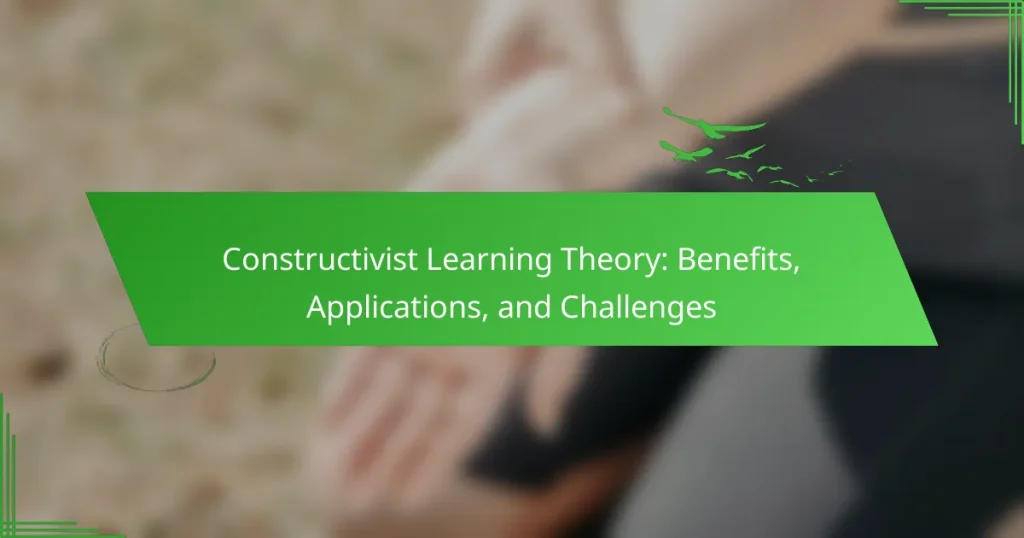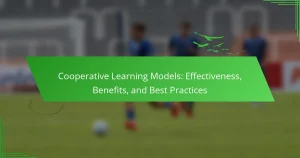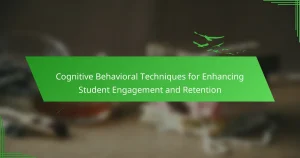Constructivist Learning Theory enhances student engagement and critical thinking skills while promoting personalized learning experiences. This article explores its benefits, diverse applications in educational settings, and challenges such as varying learning styles and resource limitations. Understanding these aspects can help educators implement effective strategies for fostering collaboration and deeper understanding among students.

What is Constructivist Learning Theory?
Constructivist Learning Theory emphasizes that learners construct knowledge through experiences. This approach fosters critical thinking and problem-solving skills. Benefits include enhanced engagement, personalized learning, and collaboration. Applications span various educational settings, from classrooms to online platforms. Challenges involve diverse learning styles and resource limitations.
How does Constructivist Learning Theory differ from traditional learning theories?
Constructivist Learning Theory emphasizes active participation and personal experience, while traditional learning theories focus on passive reception of information. Constructivism fosters critical thinking and collaboration, whereas traditional methods often emphasize rote memorization. This approach is beneficial for developing problem-solving skills and adaptability in learners. Constructivist methods apply in diverse settings, from classrooms to online platforms, but face challenges like resource requirements and educator training.
What are the foundational principles of Constructivist Learning Theory?
Constructivist Learning Theory emphasizes active engagement, where learners construct knowledge through experiences. Foundational principles include the importance of prior knowledge, social interaction, and real-world relevance. Learners build understanding through collaboration and reflection, enhancing retention and application of concepts. This theory encourages critical thinking and problem-solving skills, making learning more meaningful.

What are the universal benefits of Constructivist Learning Theory?
Constructivist Learning Theory offers numerous universal benefits, enhancing engagement and retention. It fosters critical thinking, encourages collaboration, and promotes personalized learning experiences. Students construct knowledge through active participation, leading to deeper understanding and application of concepts. This approach cultivates lifelong learning skills, preparing individuals for real-world challenges.
How does it enhance critical thinking skills?
Constructivist learning theory enhances critical thinking skills by promoting active engagement and reflection. Learners construct knowledge through experiences, fostering deeper analysis and problem-solving abilities. This approach encourages questioning assumptions and evaluating evidence, essential components of critical thinking. Additionally, collaborative learning environments stimulate diverse perspectives, further enriching critical analysis.
What role does collaboration play in learning outcomes?
Collaboration significantly enhances learning outcomes by fostering deeper understanding and critical thinking. In constructivist learning theory, collaborative activities encourage students to share diverse perspectives, facilitating knowledge construction. Research indicates that collaborative learning leads to improved retention rates and higher academic performance. Additionally, it promotes essential skills such as communication and teamwork, which are vital in real-world applications. Thus, collaboration is a cornerstone of effective learning in constructivist environments.
How does it promote deeper understanding of concepts?
Constructivist learning theory promotes deeper understanding of concepts by actively engaging learners in the process. It encourages exploration, critical thinking, and reflection, allowing individuals to construct knowledge through experiences. This approach fosters connections between new information and prior knowledge, enhancing retention and comprehension. Collaborative learning environments further support this by facilitating discussions and diverse perspectives, enriching the learning experience. As a result, learners develop a more nuanced understanding of concepts, enabling them to apply knowledge effectively in real-world situations.

What unique applications exist for Constructivist Learning Theory?
Constructivist Learning Theory has unique applications in various educational settings. It fosters personalized learning experiences, promotes collaboration among students, and encourages critical thinking. For example, project-based learning allows students to engage deeply with content while developing problem-solving skills. Additionally, flipped classrooms utilize this theory by enabling students to learn at their own pace before applying knowledge in class discussions. These applications enhance student engagement and facilitate a deeper understanding of material.
How is it implemented in classroom settings?
Constructivist learning theory is implemented in classroom settings through collaborative projects, hands-on activities, and discussions that encourage critical thinking. Teachers act as facilitators, guiding students to construct their own understanding. For example, group work allows students to share perspectives and solve problems collectively. This approach enhances engagement and retention of knowledge while fostering a deeper understanding of the material.
What are the advantages of project-based learning?
Project-based learning offers several advantages, including enhanced critical thinking, increased engagement, and improved collaboration skills. This approach fosters a deeper understanding of subject matter through real-world applications, encouraging students to take ownership of their learning.
Students develop problem-solving abilities as they navigate complex projects, which prepares them for future challenges. Additionally, project-based learning promotes creativity by allowing students to explore innovative solutions. The collaborative nature of this learning method strengthens communication skills and teamwork, essential for success in various fields.
How can technology facilitate constructivist approaches?
Technology enhances constructivist approaches by providing interactive and personalized learning experiences. Tools such as simulations, collaborative platforms, and adaptive learning systems allow learners to engage actively with content, fostering deeper understanding. For instance, virtual reality can immerse students in real-world scenarios, promoting experiential learning. Additionally, technology facilitates communication and collaboration among peers, which is essential for constructivist learning. These tools support diverse learning styles and enable feedback, aligning with the unique attribute of constructivism that emphasizes learner agency and social interaction.

What are some rare challenges associated with Constructivist Learning Theory?
Rare challenges associated with Constructivist Learning Theory include the difficulty in assessing individual learning progress, potential for knowledge gaps due to varying student experiences, and the challenge of aligning curriculum standards with personalized learning paths. Additionally, teachers may struggle with managing diverse learning styles and ensuring equitable participation among students. These factors can hinder the effectiveness of constructivist approaches in certain educational contexts.
What difficulties do educators face in adopting this approach?
Educators face several challenges in adopting constructivist learning theory. Resistance to change from traditional methods is common, as many educators are accustomed to direct instruction. Limited training on constructivist principles can hinder effective implementation. Additionally, large class sizes may restrict individualized attention, making it difficult to facilitate collaborative learning. Resource availability, including materials and technology, can also pose obstacles. Finally, assessment methods that prioritize standardized testing may conflict with constructivist approaches that emphasize critical thinking and problem-solving skills.
How can cultural differences impact the effectiveness of constructivist methods?
Cultural differences can significantly impact the effectiveness of constructivist methods by influencing learners’ motivations and interactions. For example, collectivist cultures may prioritize group learning, enhancing collaborative constructivist approaches. In contrast, individualistic cultures may favor personal exploration, potentially leading to varied engagement levels. Additionally, communication styles shaped by cultural backgrounds can affect how learners share knowledge and construct understanding, impacting overall learning outcomes. Understanding these cultural nuances is essential for educators to tailor constructivist strategies effectively.

How can educators effectively implement Constructivist Learning Theory?
Educators can effectively implement Constructivist Learning Theory by fostering active learning environments that encourage exploration and collaboration. This approach enhances critical thinking and problem-solving skills.
1. Create hands-on activities that promote inquiry-based learning.
2. Encourage group work to facilitate peer learning and diverse perspectives.
3. Integrate real-world problems to make learning relevant and applicable.
4. Provide ongoing feedback to support students’ reflective practices.
What best practices should be followed for successful implementation?
Successful implementation of constructivist learning theory requires clear objectives, active learning strategies, collaborative environments, and continuous assessment. Fostering a culture that encourages exploration enhances student engagement. Additionally, integrating technology can support diverse learning styles and facilitate access to resources. Regular feedback loops are essential for adapting strategies to meet learner needs.
What common mistakes should be avoided when applying this theory?
Common mistakes to avoid when applying Constructivist Learning Theory include neglecting individual learning styles, overlooking the importance of social interaction, and failing to provide adequate scaffolding. Additionally, it’s crucial to avoid rigid structures that inhibit exploration and discovery. Misunderstanding the role of assessment can also hinder the effectiveness of this approach, as assessments should inform learning rather than merely evaluate it. Finally, not fostering a supportive learning environment can lead to disengagement and hinder the construction of knowledge.
How can assessment methods be adapted to align with constructivist principles?
Assessment methods can be adapted to align with constructivist principles by emphasizing active learning and collaboration. These methods should focus on authentic tasks that reflect real-world challenges, promoting critical thinking and problem-solving skills.
Incorporating formative assessments allows for ongoing feedback, enabling students to reflect on their learning process. Peer assessments encourage collaboration, fostering a sense of community and shared knowledge.
Utilizing project-based assessments aligns closely with constructivist principles, as they require students to engage in inquiry and apply their knowledge in meaningful contexts. This approach enhances motivation and deepens understanding.
Finally, integrating self-assessment empowers learners to take ownership of their learning journey, aligning with the constructivist emphasis on learner agency and personal growth.

What future trends can be expected in Constructivist Learning Theory?
Future trends in Constructivist Learning Theory include increased integration of technology, personalized learning experiences, and a focus on collaborative learning environments. As technology advances, tools like virtual reality and artificial intelligence will enhance experiential learning. Personalized learning will cater to individual student needs, promoting engagement and motivation. Collaborative learning will foster critical thinking and communication skills, preparing students for real-world challenges. These trends reflect a shift towards more adaptive and student-centered educational practices.
How might advancements in educational technology influence constructivist practices?
Advancements in educational technology enhance constructivist practices by facilitating interactive learning experiences. These technologies support personalized learning, allowing students to engage actively with content and collaborate effectively. For instance, tools like virtual simulations and collaborative platforms promote critical thinking and problem-solving. Additionally, data analytics can provide insights into student progress, enabling tailored instructional strategies. Such innovations align with the core constructivist principle of learners constructing knowledge through experience and social interaction.
What changes in educational policy could affect the adoption of this theory?
Changes in educational policy could greatly enhance the adoption of constructivist learning theory. Policies promoting student-centered learning, interdisciplinary approaches, and teacher training in constructivist methods can facilitate its implementation. Increased funding for collaborative projects and technology integration also supports this theory’s principles. Furthermore, assessment reforms that value critical thinking and problem-solving skills align with constructivist objectives, encouraging broader acceptance.




